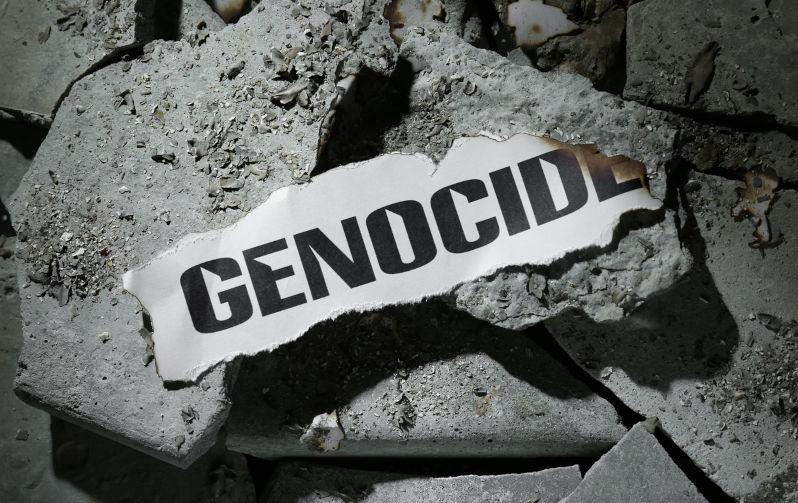So many people are speaking about genocide at the moment, but so few of them seem to know what the word means. I would like to take a moment to consider where the word comes from, and the nuances of the UN definition.
Of the 7.2 million Jews in 1939 who were living in areas that would eventually be controlled by Germany and her allies, between 5.7 and 5.9 million had been murdered by the middle of 1945 – that’s over 80% of the total.
The first of the massacres that earned the distinction of being the largest massacre of the Holocaust was the murder of over 20,000 Jews at Kamenetz Podolski in 1941. That massacre was superseded a few months later by the murder of 33,771 Jews at Babi Yar. At the time, Sir Winston Churchill, being made aware of the atrocities being perpetrated, remarked that he was “in the presence of a crime without a name”.
The largest massacre of the Holocaust was actually neither of those in the end, but the murder (in November of 1943) of 42,000 Jews in the Lublin district – mostly in the camps of Majdanek, Trawniki and Poniatowa. Astonishingly, however, all three of the above-mentioned massacres lasted only a couple of days – proof that in spite of the industrialisation of mass murder in death camps like those of Sobibor, Belzec, Treblinka and Auschwitz-Birkenau, nothing beats a shooting for efficiency.
But while that might be the case for single, stand-alone massacres, the Holocaust is best remembered for the hyper-intense kill rate (as mathematician Lewi Stone describes it) that was produced cumulatively over time. To give but one example, “Operation Reinhard” claimed the lives of almost 1.5 million Jews over a period of 100 days in 1942.
It was phenomena like this that gave impetus to the creation of the term “genocide” as a means of describing efforts at eradicating entire populations. Coined by Polish-Jewish lawyer and Holocaust survivor Raphael Lemkin, genocide was recognised as a legal concept by the United Nations in 1948, giving the nameless crime a term by which it can be understood – and hopefully prosecuted.
Sadly, there would be many other events in the 20th century that would earn the same distinction.
Starting in 1975, the Cambodian government murdered roughly 1.5 million civilians over the course of four years, and in 1994 Hutu militia murdered some 800,000 Tutsi in Rwanda over the course of only three months.
Importantly, the definition of genocide adopted by the United Nations stressed that the crime need not be one of actually eradicating an entire people (nor even seeking to eradicate an entire people – as in the above examples) but may even consist of murdering a subset of a group, so long as the victims were targeted because of the group to which they belonged. It is the “intent to murder, in whole or in part” that makes the crime genocidal.
It was this distinction that allowed the ICJ to find guilty of genocide those who were involved in the murders of 8,000 Bosniak Muslims during the Bosnian Wars – a crime that has come to be known as the Srebrenica Massacre.
What else, then, is a genocide? Regrettably, a great many things. In the aftermath of 9/11, the United States carpet-bombed Iraq, killing in addition to military personnel over 100,000 civilians. Over the ensuing eight years, there were multiple reports of massacres by US troops, torture of civilians and insurgents alike, and the commission of sexual violence. In the vacuum created by the collapse of the Iraqi state, ISIS arose, killing roughly 50,000 additional civilians by the end of 2016.
So began the 21st century, but such crimes have already been well and truly exceeded. In 2022, the United Nations estimated that the number of civilians murdered by Bashar al-Assad, the President of Syria, is in the realm of 300,000. Over 14 million people have been displaced as a result of that conflict, giving rise to what is now the largest refugee crisis in the world.
Were the civilians in each of these conflicts targeted? In all of these instances, the answer is undoubtedly (and uncontroversially) yes. As with the bombing of Dresden, or of Hiroshima and Nagasaki, the civilians were not “collateral damage” but part of the actual target. Were they therefore genocides? Whatever your politics, these should be textbook examples.
Here is an example not exactly from the book: over the course of the last five-and-a-half months, 30,000 people in Gaza have been killed.
According to Israeli records, roughly half of those people are civilians – a number that comprises slightly less than 1% of the entire Gazan population. But the numbers are not important: if the military is targeting these people in spite of their being civilians, the invasion of Gaza is an act of genocide.
Let me repeat that.
If it is the intention of the Israeli military to slim the population of Gaza, they are committing genocide whether or not they think that they are justified in doing so. By definition, that is what genocide is. Conversely, if the Israeli military is genuinely trying to reduce civilian casualties (as they continue to claim) then genocide is an incorrect term – whether or not you find the war itself a just one.
Which is it? Well, unlike the carpet-bombing of Iraq, unlike the crimes of Islamist terrorists, and unlike the murderous rampage of Assad (who is still the President of Syria), Israel’s invasion of Gaza is currently being assessed by the ICJ. We will just have to wait for their verdict. In the meantime, I leave you with a thought.
When Hamas terrorists entered Israeli towns on the border of Gaza, raping and murdering (and not always in that order), their targets were civilians. Many military reservists were also killed – in Israel, almost everybody is a military reservist – but so were a great many tourists, foreign workers and a large number of children. The means by which they hunted down and slaughtered people was barbaric and grotesque, and their celebration of those murders was truly repulsive.
Genocide is never warranted – neither in the name of “liberation”, nor in the name of subsequent “reprisals”. Hamas stands guilty (even by their own admission) of the crime of genocide – a fact that those who celebrate them as a liberation movement would do well to remember. Their crimes are not the fault of the people that they claim to represent, and the humanitarian crisis unfolding in Gaza is a tragedy of epic proportions. It demands our attention, and it demands redress.

Simon Holloway
Dr Simon Holloway is the Manager of Adult Education and Academic Engagement at the Melbourne Holocaust Museum, where he oversees the development of university, professional and corporate programs. Simon holds a PhD in Classical Hebrew and Biblical Studies and a Masters in Ancient History. The opinions expressed in his articles are exclusively his own.
